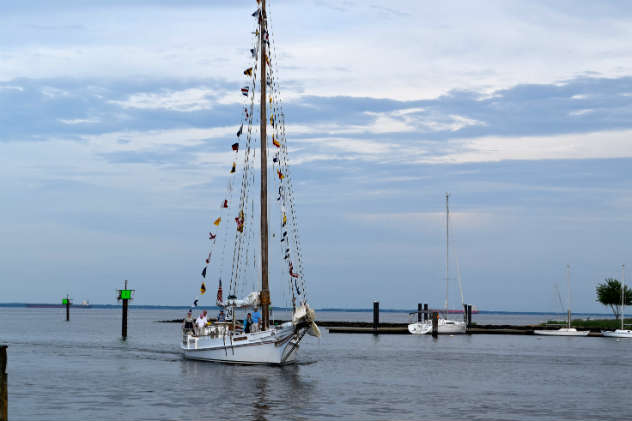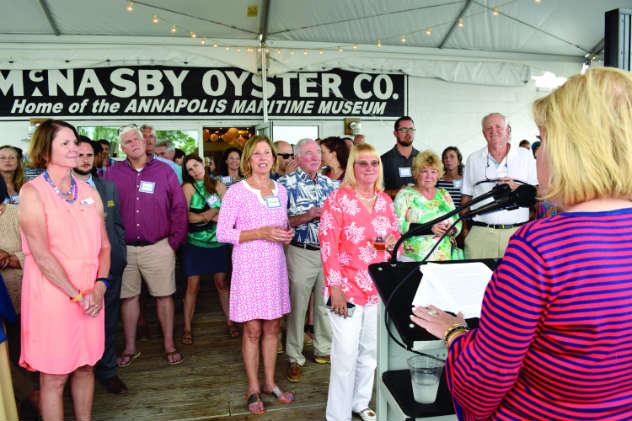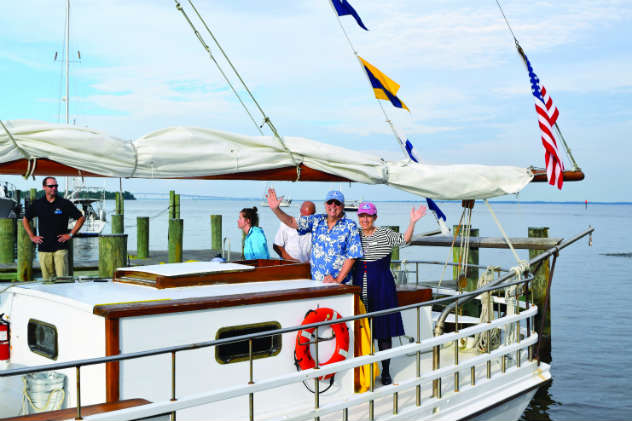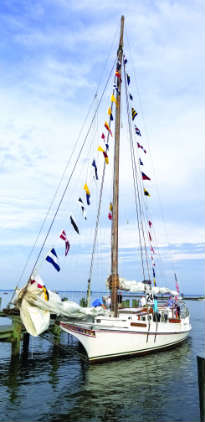1940 Skipjack To Be Part of Visitor Experience at Annapolis Maritime Museum
The historic skipjack Wilma Lee has come home to the Chesapeake from Ocracoke Island. She’s docked at the old McNasby’s oyster-packing plant in Eastport, which today houses the Annapolis Maritime Museum (AMM). Wilma Lee is a National Registered Historic Place, one of a fleet of 800 skipjacks that once dredged oysters on the Chesapeake. There are only 21 active skipjacks remaining from this original fleet (in the water and able to be sailed), and of those, only six are still being used as workboats today.
wilma-lee-AMM (3).jpg
 Skipjack Wilma Lee enters her new home waters, Back Creek in Annapolis.
Skipjack Wilma Lee enters her new home waters, Back Creek in Annapolis. Despite the threat of thunderstorms, community leaders and AMM staff and volunteers gathered on June 20 at the Museum’s pier on Back Creek, champagne in hand, cheering as Wilma Lee approached and two escort boats honored her with a water-gun salute. A signal canon fired three shots to officially announce her arrival.
The skipjack, built in Maryland in 1940 by famed boat builder Bronza Parks, was restored by Herb Carden of Sandy Point, VA, and Master Shipwright John Norganthaler in the early 2000s as a tourist attraction. In 2012, Mr. Carden donated the boat to Ocracoke Alive, a non-profit on Ocracoke Island, which promotes local arts and education initiatives, to be used as a teaching tool. Maintaining her became a challenge and rather than let her deteriorate, the graceful 75-foot-wooden vessel was put up for sale.
wilma-lee-AMM (1).jpg
 AMM's Alice Estrada speaks at the ceremony for Wilma Lee.
AMM's Alice Estrada speaks at the ceremony for Wilma Lee. When Alice Estrada, AMM’s executive director, learned that Wilma Lee was available, she knew the museum was the perfect place for the oyster-dredging vessel.
“I was approached at our annual meeting and holiday party last December by museum member Doug Tanner who has a house in Ocracoke. He told me about Wilma Lee. He was convinced we needed to have her. The rest is history,” says Estrada.
“The skipjack is a quintessential symbol of our region’s maritime heritage,” she adds. “We are thrilled to be able to return this piece of Maryland’s history to the Annapolis community.”
AMM’s leadership has big plans for Wilma Lee. Once she is repaired, polished, and certified to Maryland Coast Guard standards, the museum will welcome the community to board her for everything from yoga on the deck and painting classes to sailing tours and private weddings and charters. AMM’s first priority for Wilma Lee will be as a floating classroom for educational programs that dovetail with the museum’s mission to educate adults and youth to be environmental stewards. Visitors will learn what it was like to work in the oyster industry 80 years ago and the relationship between oysters and the Bay’s health today.
“The Wilma Lee will be a regular part of the museum’s visitor experience, including dockside tours with stories about the lives of people involved with skipjacks and the historical and environmental context of these vessels,” says John McGrath, a tour leader and docent at AMM since last November.
wilma-lee-AMM (4).jpg
 Buck Buchanan and Carol Sisco bring the skipjack home. Photos courtesy of AMM
Buck Buchanan and Carol Sisco bring the skipjack home. Photos courtesy of AMM McGrath, a retired pharmacist who has a USCG captain’s license and ABYC technician certification, was on hand at the Wilma Lee reception to guide guests aboard. “The Wilma Lee is a particularly fine example of this type of craft with a history that involves many members of Eastern Shore watermen and boat-building families. She represents a variety of connections to the past and future of oysters and oyster fishery, Maryland history, and historic boat-building crafts,” he says.
How did Wilma Lee make the trek from Ocrakoke Island to the Chesapeake? For starters, she has an inboard engine—the original skipjacks did not; instead they had a small dinghy and outboard engine to help them sail with power as needed. Watermen hoisted the dinghy above the stern, ready for inspection when dredging for oysters (which was not allowed under power).
“In addition to the inboard engine, her glossy white paint also gives her the appearance of a yacht rather than a workboat,” says McGrath. Other modern details, such as her metal railing, blend with her historic lines while maintaining safety for passengers and educational use. Despite the blistered brightwork and other cosmetic blemishes, says McGrath, “Skipjack Wilma Lee is in superb condition.”
The skipjack has twin 150-horsepower diesel inboard engines, a 250-gallon fuel tank, new boom, sails, and reconstructed stem as of 2014. Her hull was re-planked in 1997 with pressure-treated wood and stainless-steel fasteners. These are a few of the alterations needed for ICW travel.
wilma-lee-AMM (2).jpg
 Photo courtesy of AMM
Photo courtesy of AMM It took more than an inboard engine, modern modifications, and skilled crew to bring her to Annapolis. Estrada’s excitement was contagious, and following that holiday party encounter, by January 2018 the museum’s board endorsed bringing Wilma Lee home; after all, a skipjack is on AMM’s logo, and Wilma Lee is an ideal floating classroom. A generous donor worked behind the scenes to make the purchase possible, while a committee of museum leaders, expert boaters, and captains worked tirelessly to vet detailed survey documents and travel to North Carolina to examine the skipjack.
The board nominated Chairman Emeritus Buck Buchanan to chair the Wilma Lee Committee; members include Captain Craig Biggs, Denise Krizek, Carol Sisco, Eric Rubin, Captain Ed Farley, Marsha Buchanan, and museum staff.
“Buck assembled the most brilliant committee. They did their due diligence over a period of months and persevered through all the obstacles—and look what they brought us!” Estrada told the cheering crowd at the welcome reception. Buchanan and his wife, Marsha, are among those who championed Wilma Lee for the Maritime Museum. “It’s been a labor of love,” says Marsha, proudly recalling numerous trips to Ocrakoke to inspect the skipjack. Buck and Marsha are long-time supporters of the museum, since 2000, as well as skilled boaters.
“The museum’s mission is to educate and inspire young and old about Annapolis’s maritime heritage and Bay environment. The Wilma Lee gives us a wonderful new and authentic platform for our education team,” says Buck. “We can literally take our students out on the Bay under sail on a real Chesapeake Bay oyster dredger.”
Buck adds, “Marsha and I love the museum because it speaks from the heart of Annapolis: our Bay and its many coves and tributaries; our watermen and fishermen; our sailors; our oysters and our rockfish. AMM offers inspiration for all of us.”
“Obviously the preservation of a historic boat is a significant undertaking,” says Estrada. “But it’s what we must do. It is why we exist as a nonprofit: to preserve and educate Annapolis’s unique maritime history and culture. I’m dating myself, but I recall a time when the downtown harbor was loaded with workboats. That has long disappeared from our landscape.”
Thanks to AMM’s dedicated leaders, volunteers, and staff there will be a skipjack on our landscape, docked at the mouth of Back Creek, for years to come. Learn more about AMM here.
~By Patricia Dempsey




